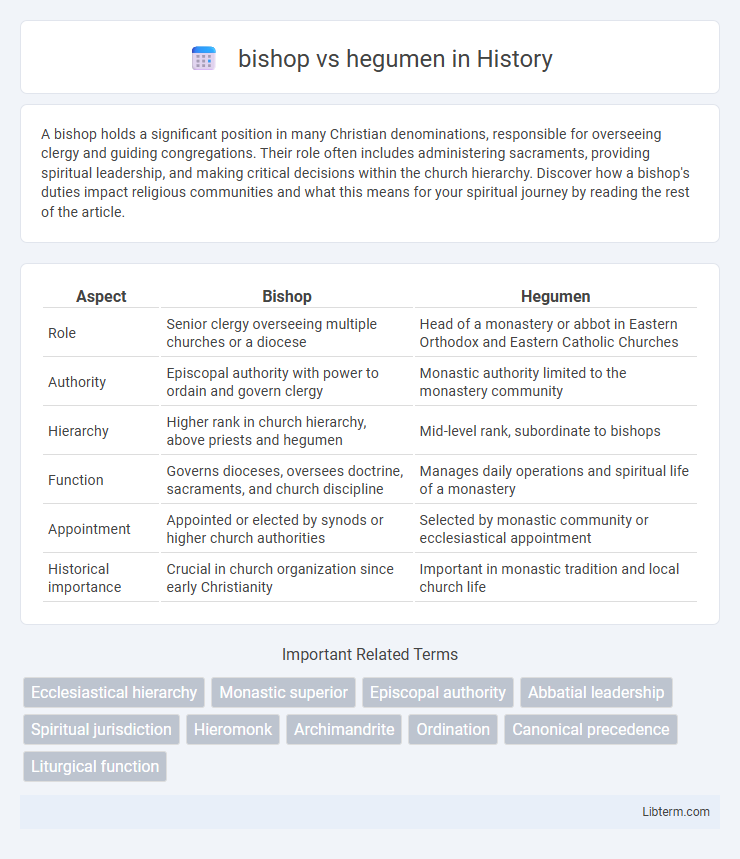A bishop holds a significant position in many Christian denominations, responsible for overseeing clergy and guiding congregations. Their role often includes administering sacraments, providing spiritual leadership, and making critical decisions within the church hierarchy. Discover how a bishop's duties impact religious communities and what this means for your spiritual journey by reading the rest of the article.
Table of Comparison
| Aspect | Bishop | Hegumen |
|---|---|---|
| Role | Senior clergy overseeing multiple churches or a diocese | Head of a monastery or abbot in Eastern Orthodox and Eastern Catholic Churches |
| Authority | Episcopal authority with power to ordain and govern clergy | Monastic authority limited to the monastery community |
| Hierarchy | Higher rank in church hierarchy, above priests and hegumen | Mid-level rank, subordinate to bishops |
| Function | Governs dioceses, oversees doctrine, sacraments, and church discipline | Manages daily operations and spiritual life of a monastery |
| Appointment | Appointed or elected by synods or higher church authorities | Selected by monastic community or ecclesiastical appointment |
| Historical importance | Crucial in church organization since early Christianity | Important in monastic tradition and local church life |
Understanding the Roles: Bishop vs Hegumen
A bishop is a high-ranking clergy member responsible for overseeing multiple parishes and ordaining priests within a diocese, emphasizing administrative and spiritual leadership. A hegumen, typically a monastic superior, manages a single monastery and focuses on the monastic community's daily spiritual and organizational life. Understanding the distinction highlights the bishop's broader ecclesiastical authority in contrast to the hegumen's localized monastic leadership role.
Historical Origins of Bishops and Hegumens
Bishops originated in early Christianity as overseers of multiple congregations, with roots tracing back to the Apostolic era, serving as spiritual leaders and administrative authorities within the church hierarchy. Hegumens, emerging primarily within Eastern Orthodox monasticism, functioned as abbots or heads of monasteries, embodying spiritual guidance and monastic discipline derived from the Greek word "hegoumenos," meaning "leader." The historical development of bishops and hegumens reflects distinct ecclesiastical traditions, with bishops holding broader ecclesial authority and hegumens focused on monastic communities and ascetic practice.
Ordination and Appointment Processes
Bishops undergo a formal consecration ceremony involving multiple bishops, symbolizing apostolic succession, and are typically appointed by higher ecclesiastical authority, such as a synod or patriarch. Hegumens, as monastic superiors, are usually ordained priests who receive their appointment through monastic community selection or diocesan bishop approval, without the extensive consecration process that bishops experience. The ordination of a bishop involves the laying on of hands and specific liturgical rites conferring episcopal authority, while a hegumen's appointment emphasizes administrative and spiritual leadership within a monastery rather than sacramental ordination.
Hierarchical Position in the Church Structure
A bishop holds a higher hierarchical position than a hegumen within the church structure, overseeing multiple parishes and clergy in a diocese, while a hegumen serves as the head of a single monastery. Bishops possess the authority to ordain priests and deacons, administer confirmations, and govern broader ecclesiastical regions, whereas hegumens primarily manage monastic communities and spiritual guidance within their monastery. The bishop's role is pivotal in church governance and sacramental duties, contrasting with the hegumen's focus on monastic discipline and leadership.
Spiritual and Pastoral Responsibilities
A bishop holds the highest spiritual authority within a diocese, overseeing multiple parishes and ordaining priests, while a hegumen serves as the spiritual leader and administrator of a single monastery. Bishops provide guidance on doctrinal matters, ensure adherence to church canons, and lead large-scale pastoral initiatives, whereas hegumens focus on the daily spiritual well-being and discipline of monastic communities. Both roles emphasize pastoral care, but the bishop's responsibilities extend to broader ecclesiastical governance and inter-parish coordination.
Authority and Decision-Making Power
A bishop holds higher ecclesiastical authority than a hegumen, overseeing multiple monasteries and diocesan clergy, while a hegumen governs a single monastery. Bishops possess decision-making power in ordaining priests, defining doctrinal matters, and managing church-wide policies, whereas hegumens primarily manage internal monastery affairs and local spiritual guidance. The authority of a bishop is recognized universally across the church hierarchy, in contrast to the more localized jurisdiction of a hegumen.
Liturgical Functions and Ceremonial Duties
The bishop oversees the entire diocese, performing liturgical functions such as ordaining priests, consecrating churches, and leading the Divine Liturgy with full ceremonial grandeur, symbolizing apostolic authority. The hegumen, as the head of a monastery, conducts liturgical services primarily within the monastic community, focusing on daily prayers, Vespers, and Matins, with a more localized ceremonial role. Bishops wear distinctive vestments like the omophorion and mitre during ceremonies, while hegumens typically don simpler monastic attire and may wear a klobuk as a sign of their office.
Relationships with Monastic Communities
A bishop maintains authoritative oversight over monastic communities, guiding spiritual practices and ensuring adherence to canonical laws, while a hegumen primarily manages the daily operations and internal discipline within a single monastery. The hegumen fosters close relational bonds with monks, focusing on communal harmony and spiritual growth, whereas the bishop's role encompasses broader diocesan responsibilities extending beyond individual monasteries. This hierarchical dynamic underscores the bishop's supervisory authority contrasted with the hegumen's intimate leadership within monastic life.
Influence on Church Administration
A bishop holds significant authority over multiple parishes and dioceses, exercising administrative control, ordaining clergy, and implementing church policies. In contrast, a hegumen governs a single monastery or a small group of monastic communities, focusing on local monastic discipline and daily operations. The bishop's influence extends broadly across the church hierarchy, while the hegumen's administrative role is localized and specific to monastic life.
Contemporary Significance and Challenges
The contemporary significance of a bishop lies in their role as a high-ranking clergy member overseeing multiple parishes and maintaining doctrinal unity within a diocese. Hegumens, serving primarily as heads of monasteries, face challenges related to balancing spiritual leadership with administrative responsibilities amid changing monastic demographics. Both roles navigate the tension between preserving traditional ecclesiastical authority and adapting to modern pastoral needs in diverse cultural contexts.
bishop Infographic

 libterm.com
libterm.com